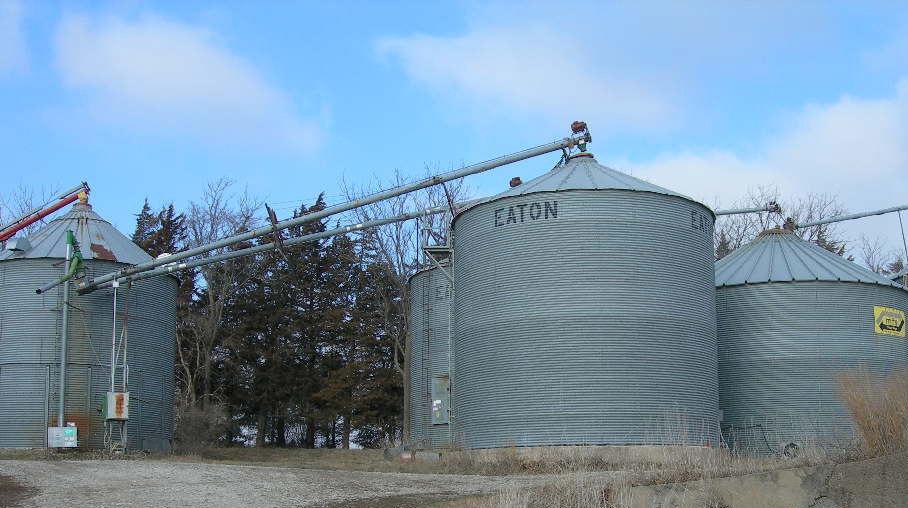Preparing Grain Bins and Equipment for Harvest

September 17, 2015
With harvest approaching, now is the time to prepare grain bins and harvesting equipment to help ensure that grain going into storage will remain in good condition. Don't wait until the middle of harvest to discover that a bin foundation is severely cracked, or find even later that insects from grain that was left in the combine last fall have severely infested a bin of new grain. Proper bin and equipment preparation is a key to preserving stored grain quality.
Harvesting Equipment
Remove all traces of old grain from combines, truck beds, grain carts, augers, and any other equipment used for harvesting, transporting, and handling grain. Even small amounts of moldy or insect-infested grain left in equipment can contaminate a bin of new grain.
Adjust combines according to the manufacturer's specifications to minimize grain damage and to maximize removal of fines and other foreign material.
Bins and Other System Components
Check the bin site, and remove any items or debris that would interfere with safe, unobstructed movement around the bin. Remove any spilled grain and mow the site to reduce the chances of insect or rodent infestation. If necessary, re-grade the site so that water readily drains away from bin foundations.
Inspect bins and foundations for structural problems. Uneven settlement of foundations can cause gaps between the foundation and bottom edge of the bin. This can result in grain spills and provide entry points for water, insects, and rodents. If perforated floors are used, a gap between the foundation and bin will allow air that would normally be forced through the grain to escape from the bin. Small gaps can usually be filled with a high quality caulking compound. If deterioration is extensive, the mastic seal may need to be replaced. Be sure all anchor bolts are tight and not damaged.
Inspect the bin roof and sides, inside and out, for leaks, loose or sheared bolts, rust or other corrosion, etc. Check the roof vents and access hatch, and caulk any cracks at the roofline. Be sure the access ladder is complete and securely fastened to the bin. Repair or replace any deteriorated components.
Wiring for fans and other electrical components should be inspected for corrosion and cracked, frayed, or broken insulation. Exposed wiring should be run through waterproof, dust-tight conduit. Avoid kinking the conduit, and make sure all connections are secure.
Check fans, heaters, transitions, and ducts for corrosion and damage. Remove any accumulated dust and dirt that will reduce the operating efficiency. Be sure that all connections are tight.
Ensure bins are clean. Remove any old grain with brooms and vacuum cleaners. Never put new grain on top of old. Also, clean bins not being used for storage this year to keep insects from migrating to other bins.
Apply Insecticides
If you think there is any chance you might hold grain in the bin into May or later, it would be prudent to apply residual insecticides to the empty bin after thoroughly cleaning it (see tables).
If the bin has a raised drying floor and was known to be infested with grain storage insects last season, consider hiring a professional pest control operator to fumigate the empty bin prior to filling with new grain.
Resources
For more information on preparing grain bins for this year's harvest, see
- Stored Grain Insect Pest Management, Purdue E-66-W
- Stored Grain Integrated Pest Management in the North Central United States (webinar)
Bob Wright, Extension Entomologist
Keith Jarvi, Extension Educator
| Table 1. Most commonly used products for insect pests in stored field corn (and soybeans, if starred). Always check and follow label directions. | |
| Products for Interior Bin Surface Applications (Use only in empty bins.) | Rate (per 1,000 sq ft) |
| Centynal (deltamethrin) | 0.25 – 1.5 fl oz in 1.0 gal |
| Diacon‐D IGR (s‐methoprene)* | 1.5 oz |
| Tempo SC Ultra (cyfluthrin)* | 0.27 fl. oz |
| Insecto, etc. (silicon dioxide, from diatomaceous earth)* | 1 lb |
| Table 2. Grain protectants applied to stored corn (and soybeans, if starred). Do not use the same compound to treat both the empty bin and the bulk grain. | |
| Product | Rate (per 1,000 bu) |
| Actellic 5E (pirimiphos‐methyl) | 9.2 ‐ 12.3 fl. oz. |
| Centynal (deltamethrin) | 8.53 fl. oz. in 5.0 gal. |
| Diacon‐D IGR (s‐methoprene )* | 8 – 10 lb |
| Sensat (spinosad) | 9.8 fl. oz. in 5.0 gal |
| Insecto (silicon dioxide from diatomaceous earth)* | 1‐2 lb per TON (Note: change in standard) |
| Table 3. Grain surface treatments for Indian meal moth in stored corn | |
| Product | Per 1,000 sq. ft. |
| Actellic 5E (pirimiphos‐methyl) | 3 fl. oz. in 2 gal. water |
| Dipel DF, Biobit (Bacillus thuringiensis, kurstaki)* | 1 lb (mixed to 4 inches deep) |
| Diacon‐D IGR (s‐methoprene)* | 8 lb (mixed to 12 inches deep) |
| Sensat (spinosad) | 2.6 fl. oz. in 2.0 gal |
Online Master of Science in Agronomy
With a focus on industry applications and research, the online program is designed with maximum flexibility for today's working professionals.
